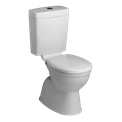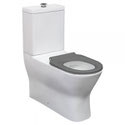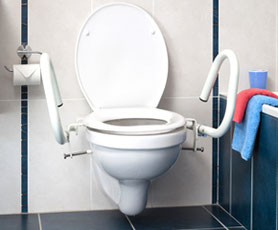Wheelchair & Ambulant Toilet Suites - Raised Height Pan toilet suites/Throne Spacer
Suited for independent living:
- Easy installation
- Provides firm support and extra assistance for sitting and standing
- Arms can pivot backwards when not in use
- Rubber coated arm for a strong grip
- Fitted between seat and pan
- Can be installed onto floor standing and wall faced toilet suites (fixings included)
- Maximum load rating: 120kg
What is the difference between Ambulant and Accessible (Disabled) facilities?
Ambulant toilets are specifically designed for those with ambulant disabilities that do not require the extra space that is provided by Accessible toilets. Primarily, they are for those that do not require the use of a wheelchair, for example, persons who have sensory loss, arthritis or require the use of a walking frame.
Accessible toilets are specifically designed to provide enough space to accommodate wheelchair access, and assistance when transferring from wheelchair to closet pan. Accessible toilets include features such as lower mirrors and washbasins, contrasting toilet seat colour, grab rails and braille signage.
Refer to “General Requirements for Access” document which details the specifications in regard to Ambulant and Accessible facility requirements, including fixture and fittings, minimum clearances and door latch requirements.
When are Accessible (Disabled) and Ambulant Toilets required? Are both Accessible and Ambulant Toilets required?
Whilst each building classification represents different ratio requirements for the provision of general sanitary facilities which is inclusive of Accessible andor Ambulant facilities, provided below is general example of the requirements for a café/restaurant use.
Where you have less than 20 patrons, there is no requirement to provide sanitary facilities for patron use, and where you have less than 10 staff you must provide at least one unisex Accessible toilet (as a minimum).
Where you have more than 20 and less than 50 patrons, general requirements include a minimum of one Accessible toilet AND the first male and female closet pan must be Ambulant compliant. Additional facilities are not required for staff as they can be incorporated into the provided patron sanitary facilities (separate staff sanitary facilities are not required) .
Where you exceed 50 patrons, any additional sanity facilities provided for patrons only need to be standard cubicles.
It is important to note that the above is a very general guide on compliance requirements. Please check the Building Code of Australia/Premises Standards (AS 1428.1) for specific information.
Ambulant Sanitary facilities
The requirements to provide AMBULANT accessible facilities was prescribed in the Building Code of Australia (BCA) in 2011 as part of the adoption of the Disability (Access to Premises-Buildings) Standards. Since the mandatory requirement for these facilities was introduced, there has been much confusion about when they are required and also the reason for providing them.
What is an ambulant accessible facility?
An ambulant accessible facility is one specifically designated for people with ambulant disabilities (such as people with arthritis or those that use a walking frame) who may find it very difficult to lower and raise from the pan but, do not require the full circulation space and support that a fully accessible toilet provides.

Toilet Seat Raiser
- The Throne Toilet Spacers have been specifically designed to raise toilet seats.
- The Spacers come in two sizes, 50mm and 80mm
- Throne Spacers are also used to raise the height of most electronic bidets
The Throne Toilet Support System of hand rails is UNIQUE and has been designed to:
- Answer the widest range of needs of assistance in toileting for both adults and children.
- Encourage independence for the user
- Provides hand rail support close to the person’s body
- Is a rigid fixture to the toilet pan
- Provides safety and confidence to the user
- No need to remove for other users
- Is easily installed and removed
- Is independent of floors and walls
THRONE ACCESSORIES ARE FOR PEOPLE WHO ARE PERMANENTLY OR TEMPORARILY INCAPACITATED, AND THE FRAIL AGED
Throne Toilet Rails have been designed specifically for the comfort and dignity of anyone requiring assistance with toileting, and for the Occupational Health and Safety needs of all carers; family, volunteers, nursing home staff, hospital and school staff.
Throne Toilet Support Rail Systems are designed for people with disabilities or impairments, including, but not limited to:
Stroke | Multiple Sclerosis | Rheumatoid Arthritis | Cerebral Palsey |Hip & Knee Replacement | Scoliosis | Sciatica | Sports Injuries |Frail Aged | Children | Post Surgery
3 in 1 Toilet Support Rail
The 3 in 1 Rail is designed for safety and comfort and benefits a range of users from the average build to the larger build persons. This Rail enables the user to have support close to the body, where it is most needed. This model has a weight loading of 120kg. The user is able to lower safely onto the toilet and pushing up from the seat is also much easier. The Rail is safer than over frames as it is rigidly fixed to the toilet pan, and also does not need to be removed for other users.The handles can also be folded down in order to facilitate a wheelchair transfer. Additionally, either one or both handles can be removed to suit some requirements.
RECOMMENDED FOR: Multipurpose use
SPECIFICATIONS:
Two optional settings: 510mm or 640mm between the handles, and fold down handles
Height of handles above seat 260mm approx
The back plate internal measurements 370mm
Easy to activate emergency buttons can be fitted to Throne Rails for safety and convenience.
Wraparound Toilet Support Rail
The Wraparound Toilet Rail has numerous benefits and has proven to be particularly beneficial for Stroke patients suffering the aftermath of muscle weakness to one side of the body. As the paralysis or weakness affects either side of the body, the design of the Wraparound Rail enables the user to grip the rail with their 'good' hand and work their hand around the top rail thereby maintaining support while turning in order to lower themselves down onto the toilet. The Wraparound model greatly minimises the chance of falls.
This model will also give MS patients great support, and anyone using a wheelchair requiring a front approach transfer will find the Wraparound Rail ideal. When standing, both hands can be used to grip each side of the rail. Hand contact with the rail can be maintained while turning into a comfortable position in order to lower onto the toilet. When seated the user has support on both sides as well as at the back.
RECOMMENDED FOR:
Stroke Sufferers, MS Sufferers, Cerebral Palsey Patients, Dementia and Alzheimer's Patients and the Frail Aged
SPECIFICATIONS:
Between hand rails 520mm
Height above seat 270-300mm
Depth from vertical front Rail position to base plate 460mm
Adult back plate internal measurements 370mm
Sloped Rail
The Sloped Rail is very flexible in terms of space and access. The handles can be positioned to suit the user's requirements. The handles are height adjustable and can be rotated to a required setting. This model is particularly useful for taller people, sports injuries patients suffering back, hip or knee complaints or fractures to lower limbs.
The Sloped Rail is also suitable for wheelchair transfers and benefits cramped toilet spaces particularly where door closure is an issue with equipment.
RECOMMENDED FOR: Sports Injuries, Post-operative Patients, Back Trauma, Hip and Knee injuries, Fractures to lower limbs
SPECIFICATIONS:
Between handles 500mm
Height above seat 350mm
Handle rotation 360°
Adult back plate internal measurements 370mm
Easy to activate emergency buttons can be fitted to Throne Rails for safety and convenience.
Bariatic rail
The Bariatric Toilet Rail is designed to assist the larger build. This particular rail can hold weight up to 150kg to 180kg.
With its free standing feet and rubber grips, the Bariatric rail relies on the floor of the bathroom/toilet, rather than being supported by the toilet itself, providing excellent stability. The legs and feet are set back so as to be of no hindrance to the user.
RECOMMENDED FOR:
Larger Built People, tested up to 180kg. Throne Bariatric rail will fit with the entire range of Throne Accessories Spacers.
SPECIFICATIONS:
Distance Between Hand Rails: Approx 600mm
Height Above Seat: 250mm (with adjustable legs)
Contact Us
Bathrooms and Kitchens
Builders Express Underwood
Tel: 0402 929 756
Email: bathroomsnkitchens@gmail.com
Website: www.bathroomsnkitchens.com.au











































